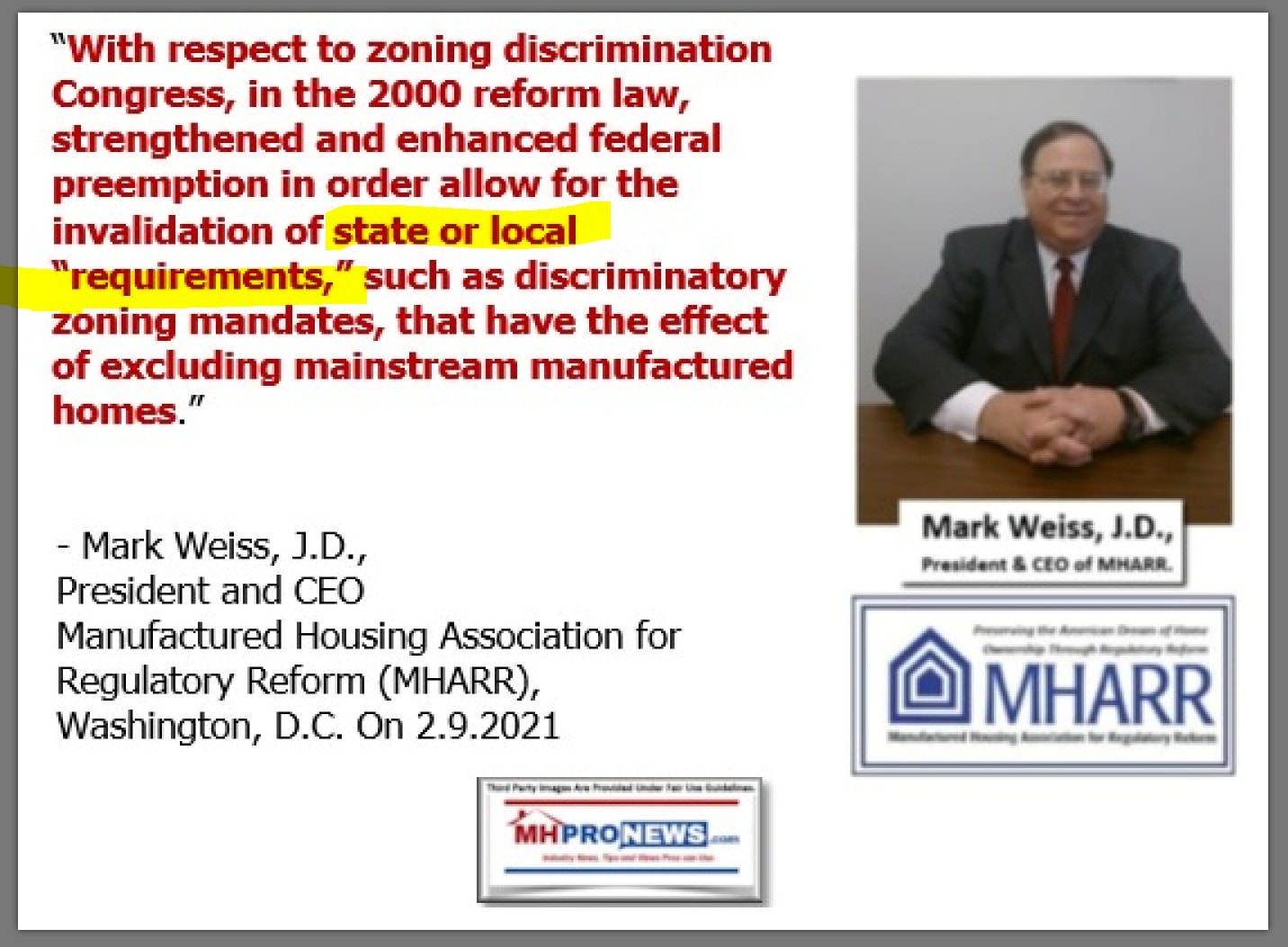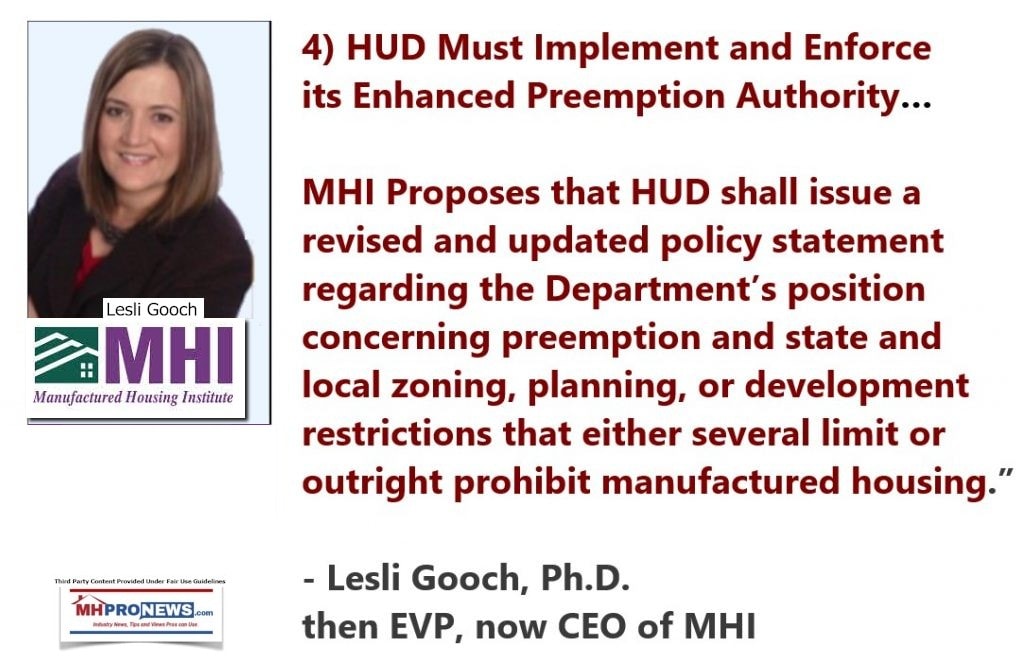“The first step in solving a problem is to recognize that it [the problem] does exist.” Zig Ziglar, per Brainy Quote.
When it comes to the affordable housing crisis, over thirteen months ago a seminal report was published on the U.S. Department of Housing and Urban Development (HUD) Policy Development and Research (PD&R) website. Mainstream media largely missed it, yet it is a powerful evidence-based study. For some, HUD’s PD&R research was ‘stating the obvious,’ but for those who are unaware of the dynamics of supply and demand it was a series of groundbreaking admissions. A series of pull quotes from that report tells a powerful tale that has implications for literally every American. Be someone:
- a renter,
- some form of conventional housing owner,
- mobile home,
- manufactured home,
- or modular housing owners,
- or are among the estimated 600,000 (+/-) who are homeless,
these insights from that research and others have practical implications that will be unpacked following the HUD researchers’ pull quotes below.
The following are all quotations from this HUD webpage link here.

…
The consequences of inadequate supply are higher housing costs for both renting and buying a home. More than 37 million renter and owner households spent more than 30 percent of their income for housing in 2019. In the years prior to the pandemic, low interest rates for mortgage loans and increasing incomes, not lower home values, had reduced owner cost burden. For renters, increasing incomes were matched by rising rents, maintaining cost burdens despite a strong economy.
Without significant new supply, cost burdens are likely to increase as current home prices reach all-time highs, with the median home sales price reaching nearly $375,000 by July 2021. These data emphasize the urgency of employing opportunities for increasing the supply of housing and preserving the existing housing portfolio.”
That statement, is a reflection of the law of supply and demand in action. That statement and related notion is widely held, and housing is a prime example of the law of supply and demand at work in the real world.
Note that HUD PD&R researchers/writers Pamela Blumenthal and Regina Gray, the co-authors of this referenced report, stress the need for a “significant new supply, cost burdens are likely to increase as current home prices reach all-time highs…”
HUD’s researchers didn’t say that the homes must all be one type of new construction vs. another. Blumenthal and Gray linked a HUD report that demonstrated how long this issue has been ongoing called “Not in My Back Yard.” The subheading for that report is “Removing Barriers to Affordable Housing.” Per the HUD NIMBY (Not in My Back Yard) report:
- That report specifically addresses modular housing 29 times.
- Manufactured housing is mentioned 38 times.
- Mobile homes are mentioned 8 times.
- Prefabricated units are mentioned twice.
- Accessory dwellings are referenced 36 times.
- The balance of the 168 pages would include numerous references to apartments and other forms of multifamily housing, duplexes, or single-family conventional construction.
From the executive summary from the NIMBY report is this.
“All States should undertake an ongoing action plan, at both the State and local levels, directed at barrier removal. As part of such a strategy, States should thoroughly review their existing zoning and land planning systems and remove all institutional barriers to affordability. These include limitations or prohibitions constraining the use of various housing affordability options such as accessory apartments, duplexes, manufactured housing, and single-room occupancy housing. States should also continue their ongoing efforts directed at building-code reform as well as consolidate and streamline their own regulatory responsibilities.”
So, while HUD’s Blumenthal and Gray don’t directly mention manufactured housing, one of their linked HUD research reports on NIMBYism does. That noted, back to duos narrative published by HUD on 9.7.2021.
“The regulatory environment — federal, state, and local — that contributes to the extensive mismatch between supply and need has worsened over time. Federally sponsored commissions, task forces, and councils under both Democratic and Republican administrations have examined the effects of land use regulations on affordable housing for more than 50 years. Numerous studies find land use regulations that limit the number of new units that can be built or impose significant costs on development through fees and long approval processes drive up housing costs. Research indicates higher housing costs also drive up program costs for federal assistance, reducing the funds available to serve additional households.”
MHLivingNews made a similar report several weeks prior to Blumenthal’s and Gray’s research-based observations. It was entitled “Why So Few Affordable U.S. Homes? Federal & Other Research – Monopolies, Moats, Manufactured Housing – Impacts Renters, Current Manufactured Homeowners, Conventional Homeowners, Most Americans.” The article below, which cited a range of sources including HUD, was posted on August 2, 2021.
Several possible takeaways from the above could be made. While the duo linked research on manufactured housing they did not specifically mention it in their own narrative for HUD’s Edge.
- This statement: “Democratic and Republican administrations have examined the effects of land use regulations on affordable housing for more than 50 years” ought to be eye-popping.
- Another is that regulatory barriers are a key bar to more affordable housing.
- The Manufactured Housing Improvement Act (MHIA) of 2000 is not mentioned, even though HUD is the primary regulator.
Let’s briefly note that some think that the shortfall of housing united needed in the U.S is far greater than 3 million. The report linked below from the Rosen Consulting Group (RCG) to the National Association of Realtors provides relevant insights that millions of more units were needed then and that ‘gap’ of supply and demand has only grown since.
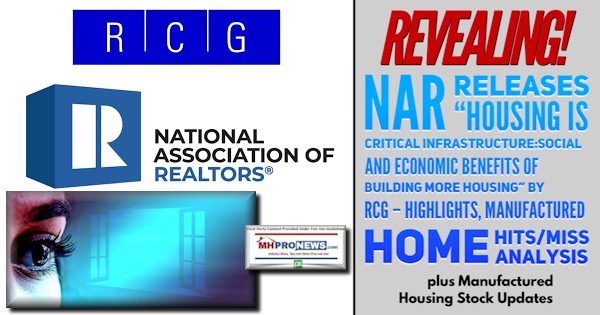
That said, per Congress and Gov.Info is this. The formal title is as shown.
42 U.S.C.
United States Code, 2012 Edition
Title 42 – THE PUBLIC HEALTH AND WELFARE
CHAPTER 70 – MANUFACTURED HOME CONSTRUCTION AND SAFETY STANDARDS
Sec. 5401 – Findings and purposes
That is followed by Congress’ “findings and purposes” to their research before they enacted the following by a widely bipartisan margin.
(a) Findings
Congress finds that—
(1) manufactured housing plays a vital role in meeting the housing needs of the Nation; and
(2) manufactured homes provide a significant resource for affordable homeownership and rental housing accessible to all Americans.
(b) Purposes
The purposes of this chapter are—
(1) to protect the quality, durability, safety, and affordability of manufactured homes;
(2) to facilitate the availability of affordable manufactured homes and to increase homeownership for all Americans;
(3) to provide for the establishment of practical, uniform, and, to the extent possible, performance-based Federal construction standards for manufactured homes;
(4) to encourage innovative and cost-effective construction techniques for manufactured homes;
(5) to protect residents of manufactured homes with respect to personal injuries and the amount of insurance costs and property damages in manufactured housing, consistent with the other purposes of this section;
(6) to establish a balanced consensus process for the development, revision, and interpretation of Federal construction and safety standards for manufactured homes and related regulations for the enforcement of such standards;
(7) to ensure uniform and effective enforcement of Federal construction and safety standards for manufactured homes; and
(8) to ensure that the public interest in, and need for, affordable manufactured housing is duly considered in all determinations relating to the Federal standards and their enforcement. …”
Per Congress.gov is the fact that the MHIA of 2000 was part of the following bill.
H.R.5640 – American Homeownership and Economic Opportunity Act of 2000106th Congress (1999-2000)
The highlights of that are found at this link here.
Congress and others have found that home ownership is closely linked to economic opportunity in America. As MHLivingNews and our MHProNews sister site has previously noted the relevant remarks about manufactured housing and building generational wealth by former HUD Secretary Ben Carson, M.D., who said: “millions of hardworking Americans who seek affordable rents or sustainable homeownership simply cannot get their foot in the door. We have reached the point where many of our nation’s teachers, nurses, police officers, and firefighters struggle to live in or around the communities they serve.
What they face is a critical shortage in our country’s supply of affordable homes.
This is not just a housing crisis – it has a human face. Homes are at the heart of building strong families, strong communities, and ultimately, a strong country.
HUD’s mission is to ensure all Americans have access to safe, quality, and affordable housing. And we believe that manufactured housing has a promising role to play – especially in the area of quality affordable housing.
For that reason, one year ago, I announced that HUD was in position to usher in a “new era of cooperation and collaboration between our Department and the manufactured housing industry.””
Dr. Carson continued by saying this.

Affordable Housing
Our nation’s shortage of affordable housing is ultimately an issue of supply and demand. With millions of people in need, high demand is already guaranteed. That’s why HUD has focused our strategy on increasing supply – namely, by promoting initiatives, programs, techniques, and technologies that produce more affordable homes.
Since the key constraint on supply is the cost of new construction and development, the solution to the problem is to change the cost side of the equation.
Manufactured housing has emerged out of the limestone and stepped into the limelight, to address precisely this need.”
Dr. Carson noted that manufactured homes that year (2019) was reportedly under half the construction cost of conventional housing. That percentage of savings has been similar since his talk on that topic.
Then-Secretary Carson said this.

And yet, even at this lower price, manufactured homes appreciate in value at a rate similar to site-built homes, according to the Federal Housing Finance Agency Housing [FHFA] Price Index. Sustainable homeownership is the number one builder of financial capital for most American families. For example, the average net worth of a renter is $5,000 [dollars], while the average net worth of a homeowner is $200,000 [dollars]. That’s an extraordinary 40-fold difference. But with comparable home appreciation rates to site-built homes, manufactured homes exhibit their own extraordinary potential to be a wealth creation tool for ordinary, everyday American families.”
Members of Congress and both national trade association leaders have said that the MHIA (referred to by MHARR as the 2000 Reform Law) gave HUD the power of “enhanced preemption” for manufactured homes over local zoning barriers.
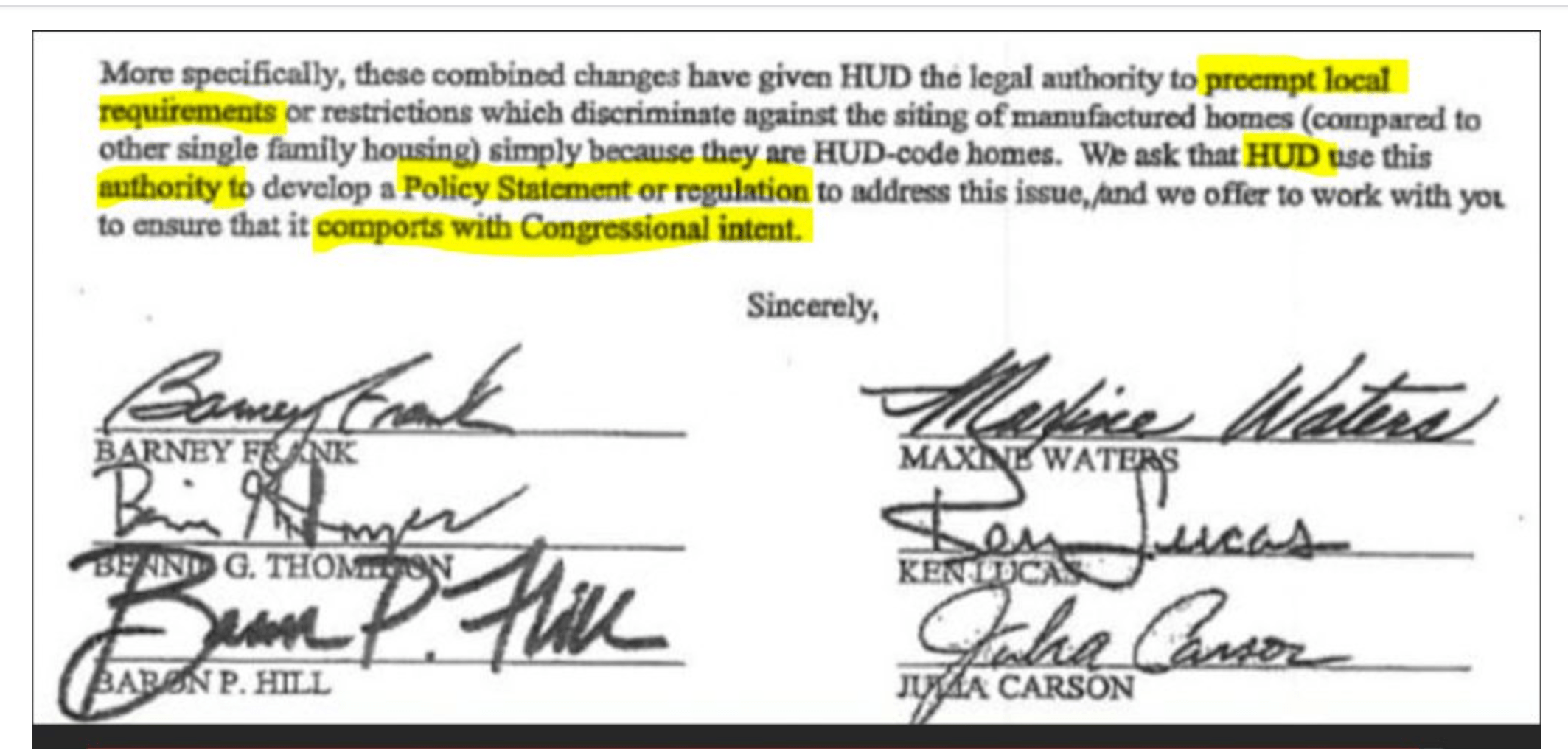
Put differently, the very problem that Blumenthal and Gray cited – local barriers to affordable housing – was supposedly ‘SOLVED’ by Congress in 2000 when the MHIA was enacted. So why isn’t the law being properly enforced? That is implied or stated by members of Congress and both national trade association comments.
Summing Up and Conclusion
Dr. Carson’s remarks, HUD and FHFA research made the points that:
- most renters could afford the payments of a modern new manufactured home.
- The National Association of Realtors (NAR) CBE Scholastica “Gay” Cororaton research made a similar finding.
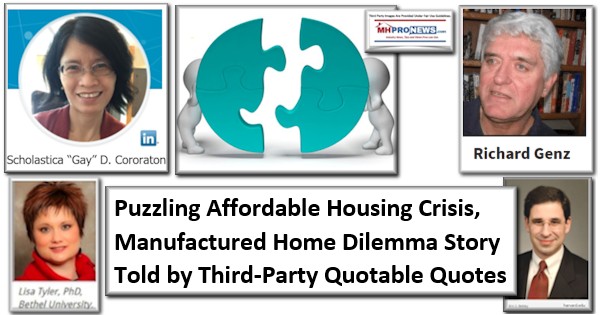
- Dr. Carson’s remarks made it clear that there was a need for a new era of cooperation between manufactured housing and HUD when he said that: “I announced that HUD was in position to usher in a “new era of cooperation and collaboration between our Department and the manufactured housing industry.””
- The MHIA was signed into law by President William Jefferson “Bill” Clinton (D) after being passed in a bipartisan fashion by Congress. Congress made it part of an affordable housing law that was supposed to increase economic opportunities for people of all backgrounds.
There is an irony in HUD saying through Blumenthal’s and Gray’s research that regulatory barriers are a key factor in the lack of affordable homes. Yet, Secretary Carson pledged a new era of cooperation to help manufactured housing achieve its promised Congressional goals.
How has this gone sideways? That will be the subject of a planned follow up report.
We began with this quotation from the late Zig Ziglar: “The first step in solving a problem is to recognize that it [the problem] does exist.” We know from research such as that shown that much of the affordable housing crisis can be boiled down to NIMBYism, the related regulatory barriers, and too little housing of all kinds being built, but more specifically too few manufactured homes are being built.

Ironically, the solution was passed by Congress some 22 years ago in the MHIA of 2000. The solution is to implement existing laws, including the so-called “enhanced preemption” provision of federal law that could be deployed to overcome local zoning barriers and NIMBYism. This demonstrates that this isn’t a partisan issue, it is as HUD’s researchers said or implied, a problem that involves yet transcends both major parties.
The complete HUD report by researchers Blumenthal and Gray with illustrations that are not shown above is linked here as a download. Dr. Carson’s remarks on manufactured housing and related from HUD, Congress, and others are linked here. ##





That’s a wrap on this installment of “News through the lens of manufactured homes and factory-built housing” © where “We Provide, You Decide.” © ## (Affordable housing, manufactured homes, reports, fact-checks, analysis, and commentary. Third-party images or content are provided under fair use guidelines for media.) (See Related Reports, further below. Text/image boxes often are hot-linked to other reports that can be access by clicking on them.)

By L.A. “Tony” Kovach – for MHLivingNews.com.
Tony earned a journalism scholarship and earned numerous awards in history and in manufactured housing. For example, he earned the prestigious Lottinville Award in history from the University of Oklahoma, where he studied history and business management. He’s a managing member and co-founder of LifeStyle Factory Homes, LLC, the parent company to MHProNews, and MHLivingNews.com. This article reflects the LLC’s and/or the writer’s position, and may or may not reflect the views of sponsors or supporters.
Connect on LinkedIn: http://www.linkedin.com/in/latonykovach
Recent and Related Reports:
The text/image boxes below are linked to other reports, which can be accessed by clicking on them.
Celebrities, Millionaires, Billionaires and Their Appealing Manufactured Homes
Lifestyles of the Rich and Frugal: Manufactured Mansions Take Their Place in the California Sun
 manufacturedhomelivingnews.com Manufactured Home Living News
manufacturedhomelivingnews.com Manufactured Home Living News

